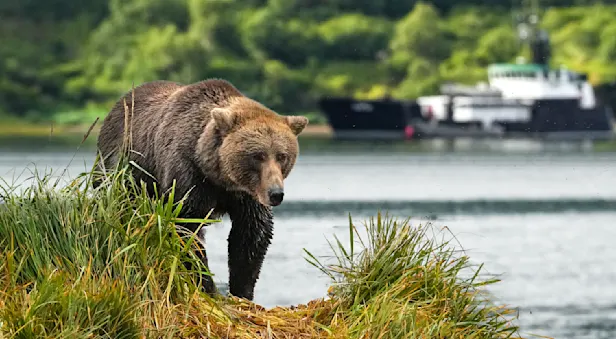
Know Before You Go


Orca Facts | Alaska Wildlife Guide
Physical Characteristics
Orcas (Orcinus orca), also called killer whales, are the largest members of the dolphin family. These sea-dwelling mammals are widely intelligent and boast incredible social organization. Orcas are large and robust, with a blunt head and reduced beak. The killer whale has a shiny black body, with white areas on the belly, flank and behind the eye. The lower jaw and throat are also white. The undersides of the flukes are white, and white lobes extend upwards from the white belly to behind the dorsal fin. A grey saddle patch is found behind the dorsal fin, the shape of which is unique to each individual whale.
Males are 20 to 30 feet long, while females are slightly smaller at 13 to 17 feet long. The tall dorsal fin of mature animals, especially males, can reach up to six feet in length.
Habitat
Killer whales are found throughout the world’s oceans, though they are most numerous in temperate waters. They are oceanic for the most part, but will approach the shore when attracted by food resources.
Habitat
Killer whales are found throughout the world’s oceans, though they are most numerous in temperate waters. In the western Arctic, killer whales are most often seen along the Alaskan coast, west of Point Barrow.
Feeding Habits
Killer whales are versatile predators. They hunt in groups of three to forty animals and feed on everything from fish and invertebrates to dolphins, porpoises, seals, sea lions, seabirds, and even whales. Orcas must eat two to five percent of their body weight in food each day, making access to a substantial and reliable food source important. Depending on their environment, fish and squid generally form the bulk of their diet. Methods for feeding on squid are unknown, but when hunting in packs, the whales trap and attack prey simultaneously. Killer whales off the coast of Alaska feed on gray and minke whales, walrus, beluga, and seals.
Behavior
Orcas are highly social whales, traveling in social units called pods. Each pod contains one adult male, several adult breeding females and a number of juveniles of both sexes; female calves usually remain in the pod of their birth. Pod size may vary from four to forty orcas. Small pods are less stable and may die out within a generation, probably because the larger pods monopolize preferred food resources. The orcas hunt together, which accounts for the social links that result in pod formation.
Breeding
Mating is thought to occur sometime between May and July. A female will bear a single calf approximately every eight years, which is about the time it takes for a male calf to reach maturity. The gestation period lasts about 15 months, and the calf measures just over six feet at birth. The mother will nurse the calf for one year.
See Orcas on These Alaska Adventures

Alaska's Grizzly Ship: Kodiak to Katmai
An exclusive small-ship adventure to view giant brown bears—the world's largest "coastal grizzlies"—up close! Walk the shores as bears dig for clams, forage for sedges and pursue salmon in season in tidal streams.
































